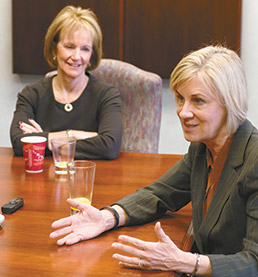IL Staff for www.theindianalawyer.com
When Loretta Rush was named chief justice of the Indiana Supreme Court in August, Indiana hit a milestone. For the first time, all of our state’s appellate courts were being led by women. Indiana Lawyer recently invited Indiana Chief Justice Loretta Rush, Indiana Court of Appeals Chief Judge Nancy Vaidik, Indiana Tax Judge Martha Wentworth and Chief Judge Robyn Moberly of the U.S. District Court for the Southern District of Indiana’s Bankruptcy Court to discuss their career paths as well as the opportunities and challenges today’s courts and lawyers face. While our spirited, 70-minute roundtable narrative required editing, a full version of the conversation can be found online at www.theindianalawyer.com/judicialroundtable2014.
 Chief Judge Robyn Moberly of the U.S. Bankruptcy Court for the Southern District of Indiana (left) listens to Indiana Court of Appeals Chief Judge Nancy Vaidik speak during a roundtable about issues facing the courts and attorneys today. (IL Photo/Eric Learned)
Chief Judge Robyn Moberly of the U.S. Bankruptcy Court for the Southern District of Indiana (left) listens to Indiana Court of Appeals Chief Judge Nancy Vaidik speak during a roundtable about issues facing the courts and attorneys today. (IL Photo/Eric Learned)INDIANA LAWYER STAFF: The legal community’s experienced a unique moment in 2014 with women stepping into top leadership posts, or already in top leadership posts, in both our state and federal courts. Clearly, glass ceilings have been broken. Do you feel like young women in the legal practice are still encountering prejudices or discrimination?Â
CHIEF JUDGE NANCY VAIDIK:Clearly, in the law firm, big law firm field, they are still. I think the National Association of Women Lawyers just did a survey earlier this year and only 17 percent of … equity partners in law firms are females, and so there is really still a glass ceiling when it comes to firms, big law firms.
JUDGE MARTHA WENTWORTH: It’s better. When I started practicing in 1990, you could count on one hand the number of partners in law firms that were women and the same in accounting firms. It has taken more than a decade to improve that number, but it has improved. I think there is still a glass ceiling because you tend to want to be with people who are like you, and unless we get a lot of women up in the upper echelons of business and law and all of the other people that use law firms, we’re going to have, still, a struggle. But we’re not alone, anyone different will have a struggle.
CHIEF JUDGE ROBYN MOBERLY: Maybe I’m overly optimistic about attitudes. My sense is that men have adopted some of the family roles that used to strictly fall with the women, but, nonetheless, I think there’s just some realities that when you’re at child-bearing age that’s also the time in your career where you otherwise would be stepping on the gas. I don’t know how you address that. And there are responsibilities that women have that men don’t have in their lives right now. I think that’s slowly moving, but there’s just some realities that make it difficult to build and to network and to attract clients. It’s hard if you’ve got two little babies at home to be out digging up clients.
CHIEF JUSTICE LORETTA RUSH: I have a little bit more positive spin. I started practicing in the early ’80s. I was an associate, then a partner while I had kids, and I was elected on the trial court bench. When I look around now I think it’s improved by leaps and bounds. You know, we all teach or go and present at law schools. We see 40, 50 percent of the students are (women). When I see litigants come and argue in my court, a lot are women, so I think we’ve made great inroads, and I think being talented and hard working, whether you’re a man or a woman, is going to pay off.
I think more diversity within the profession and more diversity on the bench is important. If we’re going to have trust in a judiciary, we need to look like the litigants that come before us. When I look at who’s making partner and the gains from 30 years ago, it was rough. I mean 31, 32 years ago trying a jury case, even going to a small county sometimes and showing up ready to go or having your client meet you for the first time and seeing that you’re a 25-year-old female, so I’m now very optimistic. Just the four of us sitting around here today and when I look out on the landscape, I think there are major changes ahead.Â
__________




